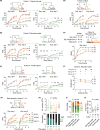Large-scale provocation studies identify maladaptive responses to ubiquitous aeroallergens as a correlate of severe allergic rhinoconjunctivitis and asthma
- PMID: 34606106
- PMCID: PMC9298287
- DOI: 10.1111/all.15124
Large-scale provocation studies identify maladaptive responses to ubiquitous aeroallergens as a correlate of severe allergic rhinoconjunctivitis and asthma
Abstract
Background: Allergic asthma (AA) and allergic rhinoconjunctivitis (ARC) are common comorbid environmentally triggered diseases. We hypothesized that severe AA/ARC reflects a maladaptive or unrestrained response to ubiquitous aeroallergens.
Methods: We performed provocation studies wherein six separate cohorts of persons (total n = 217) with ARC, with or without AA, were challenged once or more with fixed concentrations of seasonal or perennial aeroallergens in an aeroallergen challenge chamber (ACC).
Results: Aeroallergen challenges elicited fully or partially restrained vs. unrestrained evoked symptom responsiveness, corresponding to the resilient and adaptive vs. maladaptive AA/ARC phenotypes, respectively. The maladaptive phenotype was evoked more commonly during challenge with a non-endemic versus endemic seasonal aeroallergen. In an AA cohort, symptom responses evoked after house dust mite (HDM) challenges vs. recorded in the natural environment were more accurate and precise predictors of asthma severity and control, lung function (FEV1), and mechanistic correlates of maladaptation. Correlates included elevated levels of peripheral blood CD4+ and CD8+ T-cells, eosinophils, and T-cell activation, as well as gene expression proxies for ineffectual epithelial injury/repair responses. Evoked symptom severity after HDM challenge appeared to be more closely related to levels of CD4+ and CD8+ T-cells than eosinophils, neutrophils, or HDM-specific IgE.
Conclusions: Provocation studies support the concept that resilience, adaptation, and maladaptation to environmental disease triggers calibrate AA/ARC severity. Despite the ubiquity of aeroallergens, in response to these disease triggers in controlled settings (ie, ACC), most atopic persons manifest the resilient or adaptive phenotype. Thus, ARC/AA disease progression may reflect the failure to preserve the resilient or adaptive phenotype. The triangulation of CD8+ T-cell activation, airway epithelial injury/repair processes and maladaptation in mediating AA disease severity needs more investigation.
Keywords: T-cells; aeroallergen challenge chamber; allergy; asthma; phenotypes.
© 2021 The Authors. Allergy published by European Academy of Allergy and Clinical Immunology and John Wiley & Sons Ltd.
Conflict of interest statement
RLJ is the owner of the Biogenics Research Chamber. The rest of the authors declare that they have no relevant conflicts of interest.
Figures







References
Publication types
MeSH terms
Substances
Grants and funding
LinkOut - more resources
Full Text Sources
Medical
Research Materials

